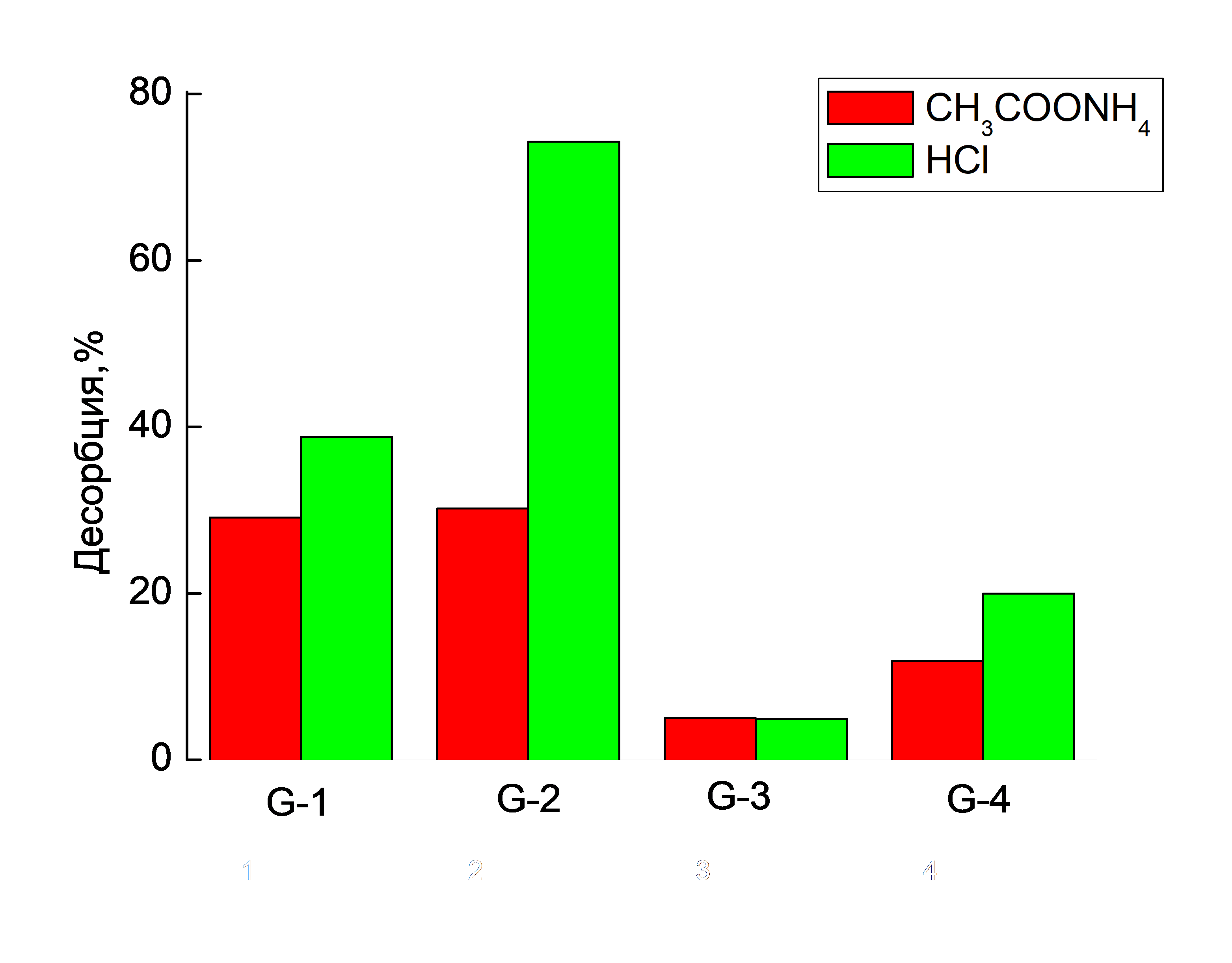BIOSORBENTS BASED ON POLYSACCHARIDES. EVALUATION OF SORPTION CAPACITY IN RELATION TO URANIUM AND THORIUM
UDC 547.992.3 + 546.841
Abstract
Study of sorption of heavy natural radionuclide’s uranium and thorium from water by β-gluсancontaining sorbents obtained from biomass of yeast Saccharomyces Cerevisiae and bran of oat Avena sativa was carried out. It is shown that the content of mobile (water-soluble, exchange and acid-soluble) and fixed forms of uranium on investigated β-glucans vary considerably. It is found that the extent of irreversible sorption of uranium does not exceed 58.6%. For the first time shown that β-glucans have high sorption capacity in ratio of thorium. In the conditions of the experiments it was retrieved more than 99% of thorium from the water. The content of fixed form of thorium reaches 94% of the sorbed. Characteristics of surface and capillary-porous structure of samples were defined. The correlation relationships between rates of adsorption and specific surface of preparations were installed. An analysis of the relationship between sorption capacity and various properties of glucans leads to the conclusion that the most important role for the implementation of a strong adsorption of heavy radionuclides belongs to chemisorptions mechanisms, while the contribution of surface physical phenomena is not essential. It is shown that the highest strong adsorption of thorium is characterized by a sample representing the cell walls of yeast Saccharomyces cerevisiae. The findings suggest of β-glucans prospects in practical terms and their use as polyfunctional enterosorbеnts.
Downloads
Metrics
References
Maher K., Bargar J.R., Brown G.E. Jr. Inorganic chemistry, 2012, vol. 52, no. 7, pp. 3510–3532. DOI: 10.1021/ic301686d.
Fesenko S., Fesenko J., Sanzharova N., Karpenko E., Titov I. Journal of Environmental Radioactivity, 2011, vol. 102, no. 1, pp. 8–25. DOI: 10.1016/j.jenvrad.2010.09.006.
Azzam E.I., Jay-Gerin J.P., Pain D. Cancer letters, 2012, vol. 327, no. 1–2, pp. 48–60. DOI: 10.1016/j.canlet.2011.12.012.
Ali S.H. Thesis for the requirement of master of Science – Medical Biology, University of Tromsø, 2009, pp. 13–18.
Chen J., Seviour R. Mycological research, 2007, vol. 111, no. 6, pp. 635–652. DOI: 10.1016/j.mycres.2007.02.011.
Petravić-Tominac V., Zechner-Krpan V., Grba S., Srečec S., Panjkota-Krbavčić I., Vidović L. Agriculturae Conspectus Scientificus, 2010, vol. 75, no. 4, pp. 149–158.
GOST 28178-89. Drozhzhi kormovyye. Metody ispytaniy. [GOST 28178-89. Fodder yeast. Test methods]. Moscow, 1987, 51 p. (in Russ.).
Buckeridge M.S., Rayon C., Urbanowicz B., Tine M.A.S., Carpita N.C. Cereal Chemistry, 2004, vol. 81, no. 1, pp. 115–127. DOI: 10.1094/CCHEM.2004.81.1.115.
Arar S., Alawi M. Acta Chromatographica, 2019, vol. 31, pp. 71–78.
Usov A.I., Bilan M.I., Klochkova N.G. Botanica Marina, 1995, vol. 38, pp. 43–51. DOI: 10.1515/botm.1995.38.1-6.43.
Lowry O.H., Rosebrough N.J., Farr A.L., Randall R.J. Journal of Biologycal Chemistry, 1951, vol. 193, pp. 265–279.
York W.S., Darvill A.G., McNeil M.А., Stevenson T.T. Methods in enzymology, 1986, vol. 118, pp. 3–40. DOI: 10.1016/0076-6879(86)18062-1
Dobrolyubskaya T.S. Analiticheskaya khimiya urana. [Analytical chemistry of uranium]. Moscow, 1962, pp. 143–165. (in Russ.).
Kuznetsov V.I., Savvin V.B. Radiokhimiya, 1961, vol. 3, no. 1, pp. 79–86. (in Russ.).
Zechner-Krpan V., Petravić-Tominac V., Panjkota-Krbavčić I., Grba S., Berković K. Agriculturae Conspectus Scientifi-cus, 2009, vol. 74, no. 4, pp. 277–282.
Petravić-Tominac V., Zechner-Krpan V., Grba S., Srečec S., Panjkota-Krbavčić I., Vidović L. Agriculturae Conspectus Scientificus, 2010, vol. 75, no. 4, pp. 149–158.
Liu F., Wang Z., Liu J., Li W. International Journal of Biological Macromolecules, 2018, vol. 115, pp. 572–579. DOI: 10.1016/j.ijbiomac.2018.04.098.
Cox C.M., Dalloul R.A. Avian Biology Research, 2010, vol. 3, no. 4, pp. 171–178. DOI: 10.3184/175815511X12919999481888.
Vetvicka V., Vetvickova J. Anticancer research, 2018, vol. 38, no. 3, pp. 1327–1333.
Mebrek S., Djeghim H., Mehdi Y., Meghezzi A., Anwar S., Awadh N.A.A., Benali M. International Journal of Phy-tomedicine, 2018, vol. 10, no. 1, pp. 58–67.
Johansson L. Structural analyses of (1→3),(1→4)-β-D-glucan of oats and barley. Dissertation – EKT series 1354. University of Helsinki, Department of Applied Chemistry and Microbiology, 2006, 85 p.
Zlatkovi D., Jakovlevi D., Zekovi D., Vrvi M.M. Journal of the Serbian Chemical Society, 2003, vol. 68, pp. 805–809.
Ames L.L., Rai D. Radionuclide interactions with soil and rock media: U. S. Environmental Protection Aqency. Report EPA 520/6 78 007A, 1978, vol. 1, 306 p.
Syromyatnikov N.G., Ivanova E.I., Trofimova L.A. Radioaktivnyye elementy kak geokhimicheskiye indikatory porodo- i rudoobrazovaniya. [Radioactive elements as geochemical indicators of rock and ore formation]. Moscow, 1976, 232 p. (in Russ.).

Copyright (c) 2019 Khimiya Rastitel'nogo Syr'ya (Chemistry of plant raw material)

This work is licensed under a Creative Commons Attribution 4.0 International License.

This work is licensed under a Creative Commons Attribution 4.0 International License.
The authors, which are published in this journal, agree to the following conditions:
1. Authors retain the copyright to the work and transfer to the journal the right of the first publication along with the work, at the same time licensing it under the terms of the Creative Commons Attribution License, which allows others to distribute this work with the obligatory indication of the authorship of this work and a link to the original publication in this journal .
2. The authors retain the right to enter into separate, additional contractual agreements for the non-exclusive distribution of the version of the work published by this journal (for example, to place it in the university depository or to publish it in a book), with reference to the original publication in this journal.
3. Authors are allowed to post their work on the Internet (for example, in a university repository or on their personal website) before and during the review process of this journal, as this may lead to a productive discussion, as well as more links to this published work.











